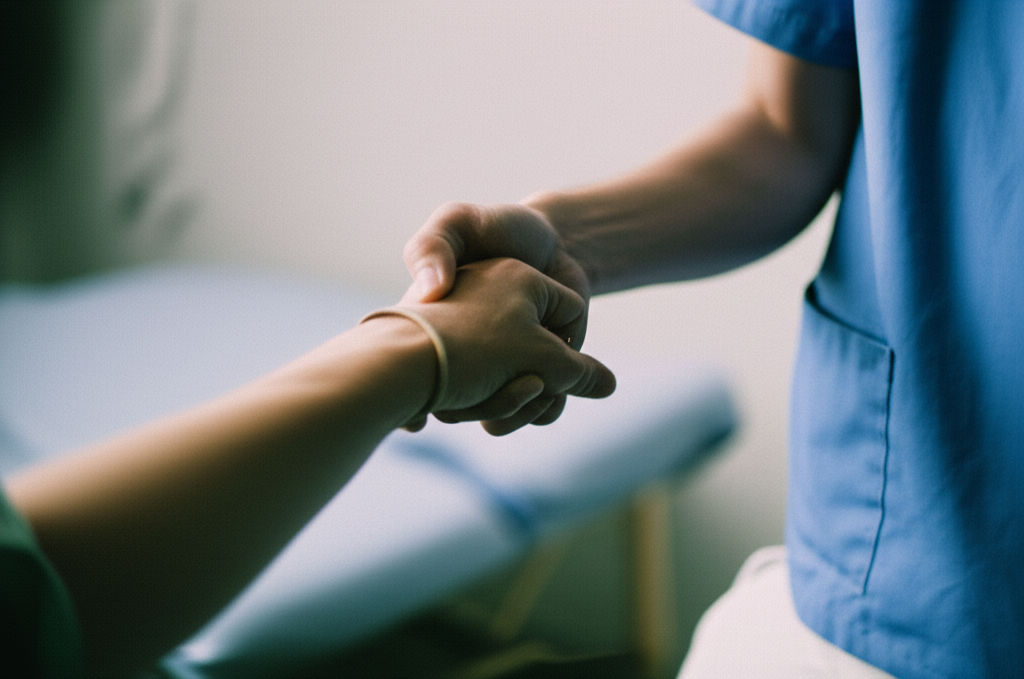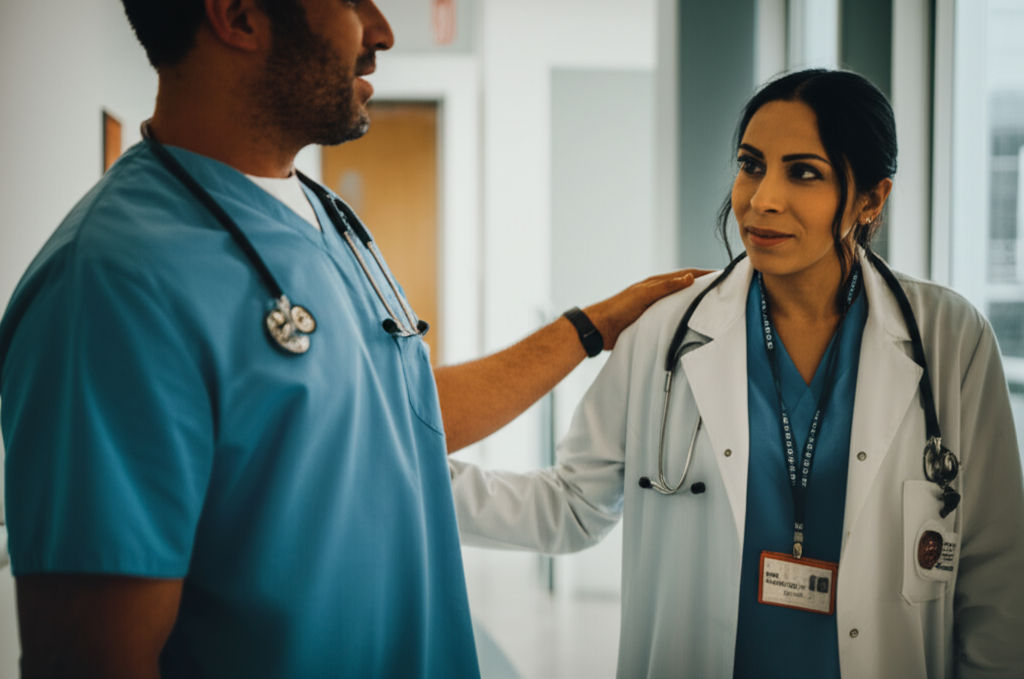What You Need to Know About Center for Sports Medicine
Ikhsan Rizki

Photo: Demystify the Center for Sports Medicine! Learn how this expert hub helps active individuals recover from injuries, prevent new ones, and optimize performance.
A sudden twist, a jarring fall, or even repetitive training can leave you sidelined, wondering who to turn to for help. If you've ever experienced a sports-related injury or simply want to optimize your physical performance, you might have heard of a "Center for Sports Medicine." But what exactly is it, and how can it benefit you? This comprehensive guide will walk you through what you need to know about Center for Sports Medicine, demystifying its role and highlighting why it might be your best ally in maintaining an active, healthy lifestyle.
What Exactly is a Center for Sports Medicine?
A Center for Sports Medicine is more than just a clinic; it's a specialized hub dedicated to the diagnosis, treatment, rehabilitation, and prevention of injuries and conditions related to physical activity and exercise. Think of it as a comprehensive support system for your body, whether you're a professional athlete, a weekend warrior, or simply someone who enjoys staying active.
Unlike general medical practices, these centers bring together a multidisciplinary team of experts. This often includes sports medicine physicians, orthopedic surgeons, physical therapists, athletic trainers, nutritionists, and other healthcare professionals, all working collaboratively to provide holistic care. Their collective goal? To get you back to doing what you love, quickly and safely, while also enhancing your overall well-being and preventing future issues.
Sports Medicine vs. Orthopedics: Understanding the Distinction
It's common to wonder about the difference between a sports medicine center and a general orthopedic practice. Both specialties deal with the musculoskeletal system (bones, muscles, ligaments, tendons, and joints), but their approaches and primary focuses can differ.
- Sports Medicine Doctors often have additional training and experience in treating injuries specifically related to sports and physical activity. They typically focus on non-surgical treatments, rehabilitation, injury prevention, and optimizing performance. Many sports medicine physicians come from backgrounds in family medicine, internal medicine, emergency medicine, or rehabilitation, with specialized fellowship training in sports medicine.
- Orthopedic Surgeons specialize in diagnosing and treating a broader range of musculoskeletal conditions, including fractures, arthritis, and other disorders that may or may not be sports-related. While they can and do treat sports injuries, their expertise often leans towards surgical interventions when necessary.
In many cases, a Center for Sports Medicine will include orthopedic surgeons as part of its team, especially for more severe injuries requiring surgical intervention. The key takeaway is that sports medicine centers often offer a more comprehensive, integrated approach tailored to the active individual, prioritizing conservative treatments and a swift, safe return to activity.
Who Benefits from a Center for Sports Medicine?
While the name suggests athletes, the truth is, a Center for Sports Medicine serves a much wider audience. If you engage in any form of physical activity, you can benefit.
- Elite and Professional Athletes: These centers are crucial for managing high-performance demands, treating acute injuries, and fine-tuning athletic performance.
- Youth Athletes: Growing bodies have unique needs. Sports medicine specialists can provide specialized care for pediatric sports injuries and guidance on safe training.
- Recreational Athletes & Weekend Warriors: Whether you play pickup basketball, run marathons, or enjoy hiking, these centers help you recover from common strains, sprains, and overuse injuries.
- Active Adults: Even if you're not a competitive athlete, if you lead an active lifestyle and experience pain or injury that limits your movement, a sports medicine center can help.
- Individuals with Chronic Pain: Many sports medicine clinics offer programs for chronic pain problems that stem from physical activity or musculoskeletal issues, such as back pain or tendonitis.
- Post-Surgery Patients: Rehabilitation is a critical part of recovery after surgery, and sports medicine centers excel at guiding patients through this process to regain full function.
Comprehensive Services Offered at a Center for Sports Medicine
A key advantage of a Center for Sports Medicine is its holistic approach to care. They offer a wide array of services designed to address every stage of your physical health journey.
1. Advanced Diagnosis and Assessment
Before any treatment begins, accurate diagnosis is paramount. Centers for Sports Medicine utilize state-of-the-art diagnostic tools to pinpoint the exact nature of your injury or condition.
- Imaging: This includes X-rays, MRIs, and musculoskeletal ultrasounds to visualize bones, soft tissues, and joints.
- Physical Examination: Thorough assessments of swelling, range of motion, strength, and stability are conducted to understand the injury's extent and contributing factors.
- Biomechanical Analysis: Some centers may assess your movement patterns to identify imbalances that could predispose you to injury.
2. Tailored Treatment Plans
Once diagnosed, a personalized treatment plan is developed. This plan might combine various methods, often prioritizing non-surgical interventions.
- Conservative Treatments:
- RICE Protocol: Rest, Ice, Compression, and Elevation are often the first line of defense for acute injuries to reduce pain and swelling.
- Medication: Pain relief medications and nonsteroidal anti-inflammatory drugs (NSAIDs) may be prescribed.
- Injections: Corticosteroid injections can help reduce inflammation and pain, while regenerative medicine techniques like Platelet-Rich Plasma (PRP) therapy and stem cell treatments can accelerate healing.
- Bracing/Immobilization: Casts or braces may be used to stabilize an injured area.
- Surgical Interventions: While often a last resort, sports medicine centers are equipped for surgical procedures when necessary, often employing minimally invasive arthroscopic techniques for faster recovery.
3. Specialized Rehabilitation and Physical Therapy
Rehabilitation is the cornerstone of recovery at a Center for Sports Medicine. It's a structured process designed to help you regain strength, mobility, and confidence.
- Pain Management: Techniques like soft tissue mobilizations, ultrasound, electrical stimulation, and massage therapy are used to alleviate pain.
- Mobility & Flexibility: Gradual stretching and exercises improve joint mobility and range of motion.
- Strength & Endurance Training: Progressive loading exercises rebuild muscle strength and stamina around the injured area and supporting muscle groups.
- Balance & Coordination: Proprioception and coordination drills help retrain your body's sense of position and movement, crucial for preventing re-injury.
- Sport-Specific Training: As you recover, rehabilitation progresses to exercises that mimic the movements of your specific sport, ensuring a safe and effective return to play.
4. Injury Prevention and Performance Enhancement
Beyond treating injuries, a significant focus of a Center for Sports Medicine is keeping you healthy and performing at your best.
- Pre-participation Physical Exams: Assessing overall health and fitness to identify potential risk factors before they lead to injuries.
- Education: Guidance on proper training techniques, body mechanics, warm-up routines, stretching, and appropriate equipment use.
- Performance Optimization: Identifying weaknesses in form, providing advice to improve strength and flexibility, and offering sports-specific recommendations.
- Nutrition Counseling: Guidance on fueling your body for optimal performance and recovery.
- Concussion Management: Specialized protocols for diagnosing and managing concussions to ensure safe return to activity.
Common Conditions Treated
What kinds of injuries and conditions bring people to a Center for Sports Medicine? The list is extensive, but some of the most common include:
- Sprains and Strains: Overstretched or torn ligaments (sprains) or muscles/tendons (strains), frequently affecting ankles, knees, and hamstrings.
- Fractures and Dislocations: Broken bones or joints forced out of alignment.
- Ligament Tears: Such as ACL, MCL, or LCL tears in the knee.
- Meniscus Tears: Cartilage damage in the knee.
- Tendonitis and Bursitis: Inflammation of tendons or bursae (fluid-filled sacs that cushion joints).
- Overuse Injuries: Conditions like shin splints, runner's knee, and stress fractures that develop gradually from repetitive stress.
- Concussions: Traumatic brain injuries resulting from a blow to the head.
- Rotator Cuff Injuries: Affecting the shoulder.
- Plantar Fasciitis: Inflammation of the tissue on the bottom of the foot, common in runners.
How to Choose the Right Center for Sports Medicine
Selecting the right Center for Sports Medicine is a crucial step toward your recovery and sustained health. Here are key factors to consider:
- Board-Certified Physicians: Ensure the doctors are board-certified, demonstrating advanced skills and a commitment to continuing education.
- Experience and Specialization: Look for physicians with extensive experience in treating sports injuries and, ideally, those with a background in orthopedics, as this provides specialized knowledge of musculoskeletal issues.
- Multidisciplinary Team: A center that offers a collaborative approach with physical therapists, athletic trainers, and other specialists under one roof ensures comprehensive care.
- Quality of Facility and Technology: Consider the center's capacity to handle and effectively treat your injuries, including access to advanced diagnostic tools and treatment technologies.
- Insurance Coverage: Always verify that the center and its physicians are in-network with your health insurance provider to avoid unexpected costs.
- Referrals and Recommendations: Ask your primary care physician, trusted friends, coaches, or fellow athletes for recommendations.
- Communication and Rapport: During an initial consultation, assess how the doctor communicates, answers your questions, and makes you feel comfortable. A good rapport is essential for effective care.
Conclusion
A Center for Sports Medicine is an invaluable resource for anyone seeking to recover from an injury, prevent future setbacks, or simply enhance their physical performance. With a team of specialized experts, advanced diagnostic tools, and comprehensive treatment and rehabilitation programs, these centers provide a holistic approach to keeping you active and healthy. Don't let an injury keep you on the sidelines; understanding what a Center for Sports Medicine offers can be your first step back into the game, stronger and more resilient than ever.
Ready to take control of your physical health? Research local Centers for Sports Medicine and schedule a consultation to discuss your needs. Your journey to optimal performance and injury-free living might just begin there!
Frequently Asked Questions (FAQ)
Q1: Do I have to be a professional athlete to go to a Center for Sports Medicine?
A: Absolutely not! While they cater to elite athletes, Centers for Sports Medicine also serve recreational athletes, active adults, youth athletes, and anyone with musculoskeletal injuries or chronic pain that impacts their active lifestyle.
Q2: What types of injuries do sports medicine doctors treat?
A: Sports medicine doctors treat a wide range of injuries, including common issues like sprains, strains, fractures, dislocations, ligament tears (e.g., ACL), meniscus tears, tendonitis, bursitis, and overuse injuries such as shin splints or runner's knee. They also manage concussions.
Q3: Is sports medicine primarily about surgery?
A: No. While some sports medicine centers include orthopedic surgeons and offer surgical options when necessary, the field of sports medicine often prioritizes non-surgical treatments and comprehensive rehabilitation. The goal is to help patients recover and return to activity using the least invasive methods possible.
Q4: How long does rehabilitation typically take after a sports injury?
A: The recovery timeline for sports injury rehabilitation varies greatly depending on the type and severity of the injury, as well as individual factors like age, overall health, and adherence to the treatment plan. Your sports medicine team will conduct a thorough assessment and create a personalized recovery plan with estimated timelines.
Business
View All
November 14, 2025
What LLC UIC Means for Your Business"LLC UIC" demystified! Learn what business ID numbers (like EIN) truly matter for your LLC's compliance and smooth operation.
Ikhsan Rizki

October 25, 2025
RI Business Search Made EasyMake your RI business search easy! This comprehensive guide helps you quickly find any Rhode Island business information you need.
Ikhsan Rizki

October 31, 2025
Shirt Size Chart for Business WearMaster your professional image! Our guide decodes shirt size charts for business wear, ensuring a perfect fit and boosting your confidence.
Ikhsan Rizki

August 29, 2025
What to Know About Car Wash BusinessesLaunch a profitable car wash! Your ultimate guide to business models, startup costs, operations, and marketing strategies for success.
Ikhsan Rizki

October 19, 2025
Tips for Successful Business MeetingsTired of pointless meetings? Discover practical tips to transform your business gatherings into productive, results-driven sessions.
Ikhsan Rizki

August 27, 2025
Healthcare Business Management PayCurious about Healthcare Business Management pay? Explore salary ranges, key factors, and how to increase your earning potential in this vital field.
Ikhsan Rizki
Economy
View AllElevate your content with stunning visuals! Discover where to get free economy clipart to enhance presentations, marketing, and blogs, even on a tight budget.
Ikhsan Rizki
Honda Civic Type R MPG: Get the surprising truth about its fuel economy. Performance meets practicality. Learn real-world facts!
Ikhsan Rizki
Discover The Economy Shop Oak Park: a century-old non-profit thrift store fueling local charities & sustainability. Shop smart, do good!
Ikhsan Rizki
Is the US economy still the world's envy? Explore its enduring strengths and emerging challenges in this balanced look at America's economic standing.
Ikhsan Rizki
Considering British Airways 787 Premium Economy? This guide unveils enhanced comfort, more space, & great value for long-haul flights on the Dreamliner.
Ikhsan Rizki
Your ultimate guide to Honda CR-V fuel efficiency. Explore MPG for gas & hybrid models, 2025 ratings, and tips to maximize savings at the pump.
Ikhsan Rizki
Education
View AllUnravel the Best State for Education Rankings! Understand the key metrics for K-12 & higher ed quality to make informed choices for your family's future.
Read MoreDiscover New Haven adult education programs! Achieve career goals, earn your GED, improve English, or gain vocational skills. Flexible & supportive pathways awa...
Read MoreUnlock potential with Universalisation of Elementary Education (UEE). Discover its meaning, vital importance, and global efforts to ensure quality education for...
Read MoreNurses: Discover remote patient education jobs! Empower patients from home, achieve work-life balance, and leverage your expertise. Your guide to this evolving...
Read MoreDiscovering Wellness and Adventure: Inside the Arrillaga Outdoor Education Center Are you seeking a place where personal growth meets thrilling adventure? Do yo...
Read MoreDiscover Educators Rising! Learn how this national organization empowers middle & high school students to become the next generation of impactful educators.
Read MoreHealth
View All
September 2, 2025
Top Health Info Management JobsUnlock your future! Explore top Health Information Management (HIM) jobs in this growing field. Combine healthcare, tech & business, no direct patient care.
Ikhsan Rizki

September 25, 2025
Sanford Health Is Hiring NowSanford Health is hiring! Discover a rewarding career making a difference in healthcare. Explore diverse roles, strong values, and growth opportunities.
Ikhsan Rizki

September 1, 2025
Gold Coast Health Plan OverviewNavigating healthcare in Ventura County? Discover Gold Coast Health Plan (GCHP) for Medi-Cal eligibility & comprehensive, affordable benefits.
Ikhsan Rizki

September 30, 2025
Start Your Ballad Health CareerDiscover a rewarding healthcare career at Ballad Health in the Appalachian Highlands. Explore diverse roles & how to apply.
Ikhsan Rizki

November 17, 2025
Use M Health MyChart TodayM Health MyChart simplifies your healthcare. Access records, message doctors, schedule appointments, and manage bills securely online. Take control of your heal...
Ikhsan Rizki

October 6, 2025
Why Choose Zufall Health CenterChoose Zufall Health Center for comprehensive, accessible, and affordable healthcare in New Jersey. Your trusted partner for patient-centered care.
Ikhsan Rizki
Popular Articles
View All
1
2
3
4
5
6
7
8
9
10
Lifestyle
View All
October 11, 2025
Dick’s Baseball Style Gear
Elevate your baseball game! Discover quality bats, gloves & essential gear at Dick's Sporting Goods – your one-stop shop for every player.

September 28, 2025
Rockstar Lifestyle Lyrics Explained
Unpack the "rockstar lifestyle" in music lyrics. Explore themes of wealth, parties, fame, and rebellion, plus their deeper meanings.

August 29, 2025
Healthy Lifestyle Clipart Ideas
Struggling with bland health content? Discover how healthy lifestyle clipart can elevate your wellness messages, making them engaging and inspiring!

September 28, 2025
Choosing the Right Condom Size
Don't guess your condom size! A proper fit is vital for safety, pleasure & preventing breakage. Learn how to measure correctly & choose the right condom for you...

November 13, 2025
Meet the team behind lifestyle staff
Meet the passionate experts behind our lifestyle content. Learn how their expertise & authenticity deliver trustworthy guides for a better life.

August 23, 2025
Life at Arborwood Preserve Today
Discover Arborwood Preserve: Fort Myers' resort-style community with luxury homes, vibrant activities & unmatched amenities. Live your dream life!

September 25, 2025
Puma Park Lifestyle Sneakers Drop
Elevate your style with Puma Park Lifestyle Sneakers! Discover urban cool, comfort, and versatile design. Your must-have for daily grind & weekend adventures.

October 8, 2025
Bose Model 5 Music System
Explore the Bose Model 5 Music System. Get immersive, room-filling sound from a sleek, compact home audio solution. Rediscover your music!
Sports





Travel
View All
August 31, 2025
Kors Jet Set Travel Bags Review
Planning your next trip? Explore our review of Michael Kors Jet Set travel bags, blending style, durability, & organization for your ultimate journey.

October 6, 2025
Best Men’s Travel Pants for Any Destination
Find your perfect men's travel pants! Our guide helps you choose comfortable, stylish, and versatile trousers for any destination. Travel smarter.

November 25, 2025
Florida Travel Packages Affordable
Unlock affordable Florida travel! This guide reveals how to find budget-friendly packages for beaches, parks & more, making your dream trip a reality.

November 10, 2025
Traveling Medical Assistant Jobs Guide
Medical Assistants: Explore the exciting world of Traveling MA jobs! Combine healthcare skills with wanderlust for a dynamic, flexible, and rewarding career.

September 19, 2025
2 Bedroom Travel Trailers
Unlock ultimate comfort & space on the road! Discover 2 bedroom travel trailers, perfect for families & groups seeking privacy & enhanced adventures.

August 13, 2025
How far bullets can travel
Unravel the science of ballistics! Discover how far bullets really travel, influenced by gravity, drag, and wind. Beyond straight lines, learn the truth.

















